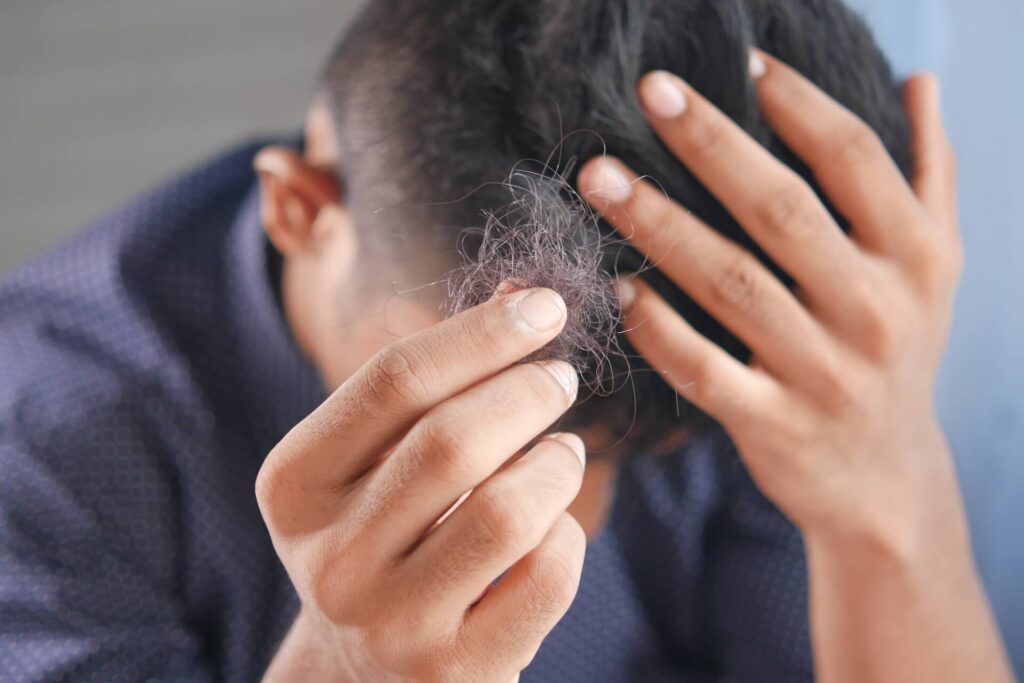Can You Go Bald From Taking TRT?
Testosterone replacement therapy (TRT) does not directly cause balding, but it can accelerate hair loss in men predisposed to male pattern baldness.
Male pattern baldness is primarily caused by genetics and the sensitivity of hair follicles to dihydrotestosterone (DHT), a byproduct of testosterone. TRT involves increasing testosterone levels in men who have low testosterone which can indirectly lead to an increase in DHT if the body converts the extra testosterone to DHT.
For men who are genetically predisposed to male pattern baldness, this increase in DHT can accelerate hair loss. This is because DHT shrinks hair follicles, shortening the lifespan of each hair and eventually leading to thinning or balding. However, for men who are not genetically predisposed to hair loss, TRT is unlikely to cause balding.
It’s important to note that everyone’s response to TRT can vary, and other factors such as age, overall health, and lifestyle can also influence hair loss.
Ways To Avoid Hair Loss While Taking TRT

DHT Blockers
DHT blockers, such as finasteride and dutasteride, are medications that help minimize hair loss, especially for men undergoing testosterone replacement therapy. DHT is a hormone derived from testosterone and is a key factor in male pattern baldness. When testosterone levels are increased through TRT, it can lead to higher DHT levels, potentially accelerating hair loss in men predisposed to balding.
DHT blockers work by inhibiting the enzyme 5-alpha-reductase. This enzyme is responsible for converting testosterone into DHT. By blocking this enzyme, DHT blockers effectively reduce the levels in the scalp.
Lower DHT levels mean a reduced impact on hair follicles, which are typically sensitive to this hormone in those with male pattern baldness. As a result, the follicles are less likely to shrink and cease producing new hair.
Topical Treatments
Topical treatments, particularly minoxidil (commonly known by its brand name Rogaine), play a significant role in combating hair loss for men on TRT. These treatments are applied directly to the scalp and are available over the counter, making them an accessible option.
Minoxidil works by stimulating hair follicles to grow. It’s a vasodilator, meaning it widens the blood vessels in the scalp, which can improve blood flow. This increased circulation delivers more oxygen and nutrients to hair follicles, strengthening them and encouraging hair growth. Additionally, minoxidil extends the growth phase of the hair cycle, which results in longer, thicker hair strands over time.
For men undergoing TRT, the use of minoxidil can be particularly beneficial. While TRT may potentially increase DHT, minoxidil helps counteract this effect by promoting new hair growth and maintaining the health of existing hair.
Healthy Diet And Lifestyle

Maintaining a healthy diet and lifestyle is crucial for overall well-being, and it plays a significant role in hair health, particularly for men undergoing testosterone replacement therapy. A balanced diet rich in essential nutrients can support hair growth and reduce the risk of hair loss.
Key nutrients that are particularly beneficial for hair health include:
Protein: Hair is primarily made of protein, so adequate protein intake is vital for hair growth. Lean meats, fish, eggs, and plant-based protein sources like lentils and beans are excellent choices.
Iron: Iron deficiency can contribute to hair loss. Including iron-rich foods like spinach, lentils, and red meat can help maintain healthy iron levels.
Omega-3 Fatty Acids: These healthy fats, found in fish like salmon and flaxseeds, are known for supporting scalp health and may improve hair density.
Vitamins and Minerals: Vitamins A, C, D, E, and B-vitamins (especially biotin) are crucial for hair growth. Zinc is another important mineral for hair repair and growth. A diet with a variety of fruits, vegetables, nuts, and seeds can help ensure adequate intake of these nutrients.
For men on TRT, a healthy diet and lifestyle not only support overall health but can also help mitigate the potential side effects of the therapy. By providing the body with the necessary nutrients and maintaining a healthy lifestyle, hair follicles can remain robust, potentially reducing the impact of TRT on hair health.
Reduced Stress
Stress can have a significant impact on hair health, potentially leading to a condition known as telogen effluvium, where hair falls out more rapidly than usual.
When the body is under stress, it can disrupt normal hair growth cycles. Hair follicles can prematurely enter the resting phase (telogen phase), leading to increased hair shedding. This type of hair loss is usually temporary, but chronic stress can prolong the condition.
To minimize stress-related hair loss while on TRT, incorporating stress-reduction techniques into daily life is beneficial. Some effective methods include:
Regular Exercise: Physical activity is a great stress reliever. Activities like jogging, swimming, or even brisk walking can help release endorphins, the body’s natural mood elevators.
Mindfulness and Meditation: Practices like meditation, deep breathing exercises, and yoga can significantly reduce stress levels, promoting a sense of calm and relaxation.
Adequate Sleep: Ensuring sufficient and quality sleep is essential for managing stress. Poor sleep can exacerbate stress, negatively impacting hair health.
Hobbies and Relaxation: Engaging in hobbies or activities you enjoy can be a great way to relieve stress.
Talking Therapies: Sometimes, discussing worries with a friend, family member, or professional can help alleviate stress.
Regular Check-Ups
Regular check-ups with a healthcare provider enable monitoring of your response to the treatment, including any side effects such as hair loss.
During these check-ups, healthcare professionals can assess hormone levels and other relevant health markers. If TRT is contributing to hair loss, they may detect elevated levels of DHT. By monitoring these levels, adjustments to the TRT regimen can be made if necessary, potentially including the dosage or frequency of the therapy.
Regular medical check-ups also provide an opportunity for patients to discuss their concerns and experiences with TRT, including any changes in hair health. This open communication allows for personalized care, ensuring that the treatment plan is effective and aligns with the patient’s overall health goals.
Conclusion About TRT And Balding
In conclusion, effectively managing hair loss associated with testosterone replacement therapy requires a proactive and multi-dimensional approach. By incorporating targeted treatments such as DHT blockers and minoxidil, alongside maintaining a healthy lifestyle and reducing stress, individuals can significantly mitigate the impact of TRT on hair health.
Regular consultations with healthcare professionals ensure personalized care and timely adjustments to treatment strategies. This holistic approach not only addresses hair loss concerns but also enhances overall well-being, demonstrating the importance of a balanced and informed approach to health management during TRT.

Ashlee is the Medical Director at Evolve Wellness and Health in Englewood, Colorado. She obtained her Master of Science in Nursing in 2006 from Colorado State University-Pueblo, and is board-certified through the American Nurses Credentialing Center as an Acute Care Nurse Practitioner. She has practiced in the field of hormone replacement therapy (both male and female) and medical weight loss since 2013.


